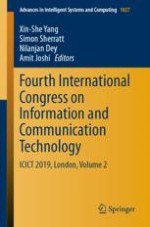The second volume of this book includes selected high-quality research papers presented at the Fourth International Congress on Information and Communication Technology, which was held at Brunel University, London, on February 27–28, 2019. It discusses emerging topics pertaining to information and communication technology (ICT) for managerial applications, e-governance, e-agriculture, e-education and computing technologies, the Internet of Things (IoT), and e-mining. Written by respected experts and researchers actively working in ICT, the book offers a valuable resource, especially for researchers who are newcomers to the field.
